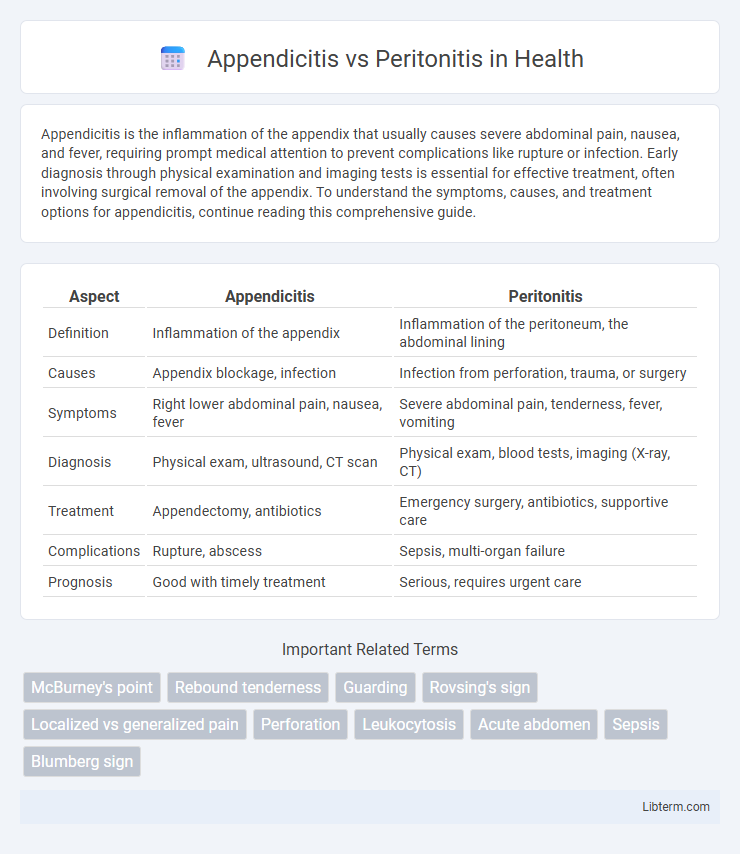Appendicitis is the inflammation of the appendix that usually causes severe abdominal pain, nausea, and fever, requiring prompt medical attention to prevent complications like rupture or infection. Early diagnosis through physical examination and imaging tests is essential for effective treatment, often involving surgical removal of the appendix. To understand the symptoms, causes, and treatment options for appendicitis, continue reading this comprehensive guide.
Table of Comparison
| Aspect | Appendicitis | Peritonitis |
|---|---|---|
| Definition | Inflammation of the appendix | Inflammation of the peritoneum, the abdominal lining |
| Causes | Appendix blockage, infection | Infection from perforation, trauma, or surgery |
| Symptoms | Right lower abdominal pain, nausea, fever | Severe abdominal pain, tenderness, fever, vomiting |
| Diagnosis | Physical exam, ultrasound, CT scan | Physical exam, blood tests, imaging (X-ray, CT) |
| Treatment | Appendectomy, antibiotics | Emergency surgery, antibiotics, supportive care |
| Complications | Rupture, abscess | Sepsis, multi-organ failure |
| Prognosis | Good with timely treatment | Serious, requires urgent care |
Introduction to Appendicitis and Peritonitis
Appendicitis is the inflammation of the appendix, a small tubular organ attached to the cecum, often causing severe abdominal pain and requiring prompt surgical intervention. Peritonitis is the inflammation of the peritoneum, the thin membrane lining the abdominal cavity, which can result from infection or rupture of an abdominal organ like a burst appendix. Early diagnosis of appendicitis is crucial to prevent progression to peritonitis, which poses a higher risk of systemic infection and complications.
Definition and Overview: Appendicitis
Appendicitis is the inflammation of the appendix, a small, tube-shaped organ attached to the large intestine, often caused by blockage or infection. It typically presents with abdominal pain, especially in the lower right quadrant, accompanied by nausea, vomiting, and fever. Early diagnosis and surgical removal of the appendix are critical to prevent complications such as rupture and the subsequent development of peritonitis.
Definition and Overview: Peritonitis
Peritonitis is a serious medical condition characterized by inflammation of the peritoneum, the thin tissue lining the abdominal cavity and covering abdominal organs. It commonly arises from infection due to perforation of the gastrointestinal tract, such as a burst appendix, leading to the spread of bacteria or fungi within the abdominal cavity. Prompt diagnosis and treatment are critical to prevent severe complications like sepsis or organ failure.
Causes: Appendicitis vs Peritonitis
Appendicitis is primarily caused by obstruction of the appendiceal lumen due to fecaliths, lymphoid hyperplasia, or infections leading to inflammation and swelling. Peritonitis arises when the peritoneum becomes inflamed, often due to bacterial or fungal infection following the rupture of an inflamed appendix, gastrointestinal perforation, or abdominal trauma. Distinguishing the causes is crucial as appendicitis involves localized inflammation of the appendix, whereas peritonitis results from the spread of infection throughout the peritoneal cavity.
Signs and Symptoms Comparison
Appendicitis typically presents with localized abdominal pain starting near the navel and shifting to the lower right quadrant, accompanied by nausea, vomiting, and mild fever. Peritonitis manifests with severe abdominal pain that is diffuse and worsens with movement, along with high fever, abdominal rigidity, and signs of systemic infection such as tachycardia and hypotension. While appendicitis signs are often localized and progressive, peritonitis symptoms indicate widespread inflammation of the peritoneal cavity and require urgent medical intervention.
Diagnostic Methods and Tests
Diagnostic methods for appendicitis primarily include physical examination, blood tests revealing elevated white blood cell count, and imaging techniques such as abdominal ultrasound or computed tomography (CT) scans to detect inflammation or enlargement of the appendix. Peritonitis diagnosis relies on clinical evaluation showing signs of abdominal rigidity, fever, and severe pain, supported by laboratory tests like elevated inflammatory markers, peritoneal fluid analysis obtained via paracentesis, and imaging studies including abdominal X-rays or CT scans to identify free air or fluid in the peritoneal cavity. Both conditions often require urgent diagnosis, with CT imaging serving as a critical tool to differentiate appendicitis from peritonitis and guide appropriate surgical or medical intervention.
Treatment and Management Approaches
Appendicitis treatment primarily involves surgical removal of the appendix, either through laparoscopic or open appendectomy, combined with pre- and postoperative antibiotics to prevent infection. Peritonitis management requires aggressive intravenous antibiotics and fluid resuscitation, alongside surgical intervention to address the underlying cause such as a perforated organ or abscess drainage. Early diagnosis and prompt treatment are critical in reducing morbidity and preventing complications like sepsis or widespread infection.
Potential Complications and Risks
Appendicitis can progress to peritonitis if the appendix ruptures, leading to a severe, life-threatening infection of the abdominal cavity. Peritonitis carries risks such as sepsis, abscess formation, and multi-organ failure due to widespread inflammation. Prompt diagnosis and treatment are critical to prevent these complications and reduce morbidity and mortality rates.
Prevention and Risk Reduction
Appendicitis prevention centers on early recognition of abdominal pain and prompt medical evaluation to avoid rupture, while maintaining a high-fiber diet may contribute to lower risk. Reducing the risk of peritonitis involves timely treatment of appendicitis or any intra-abdominal infection to prevent spread of inflammation to the peritoneum. Strict adherence to sterile surgical practices and effective management of abdominal injuries also plays a crucial role in minimizing peritonitis incidence.
Prognosis and Recovery Outlook
Appendicitis typically has a favorable prognosis with prompt surgical removal of the inflamed appendix, leading to full recovery within a few weeks for most patients. Peritonitis, caused by the infection spreading into the peritoneal cavity, carries a more severe prognosis with higher risks of complications such as sepsis, requiring intensive medical treatment including antibiotics and sometimes surgery. Recovery from peritonitis is longer and more complex, often involving extended hospital stays and close monitoring to prevent life-threatening outcomes.
Appendicitis Infographic

 libterm.com
libterm.com